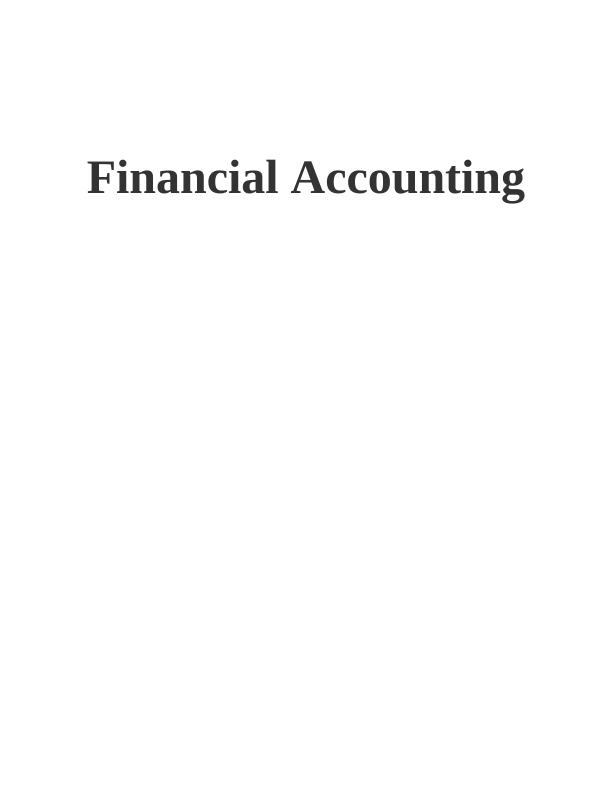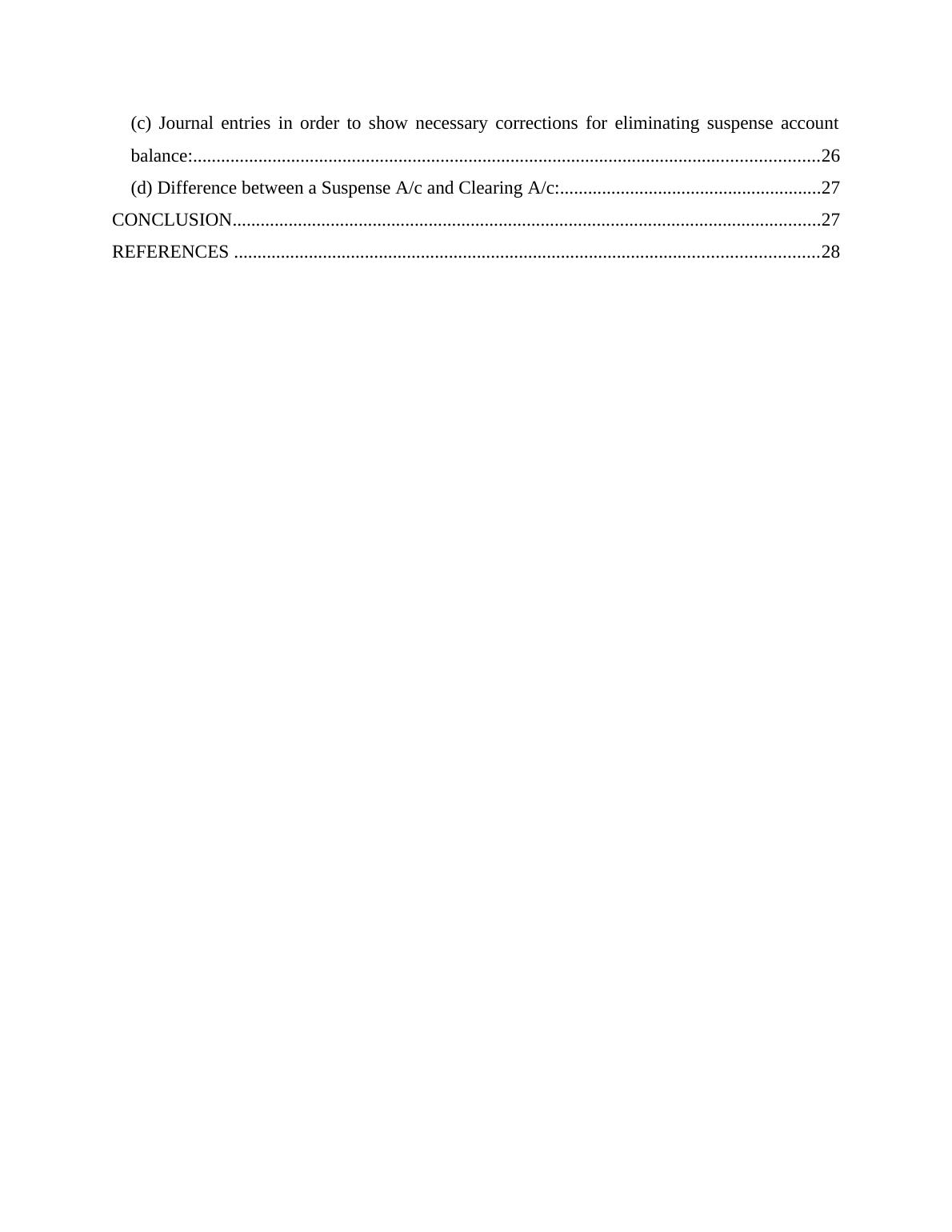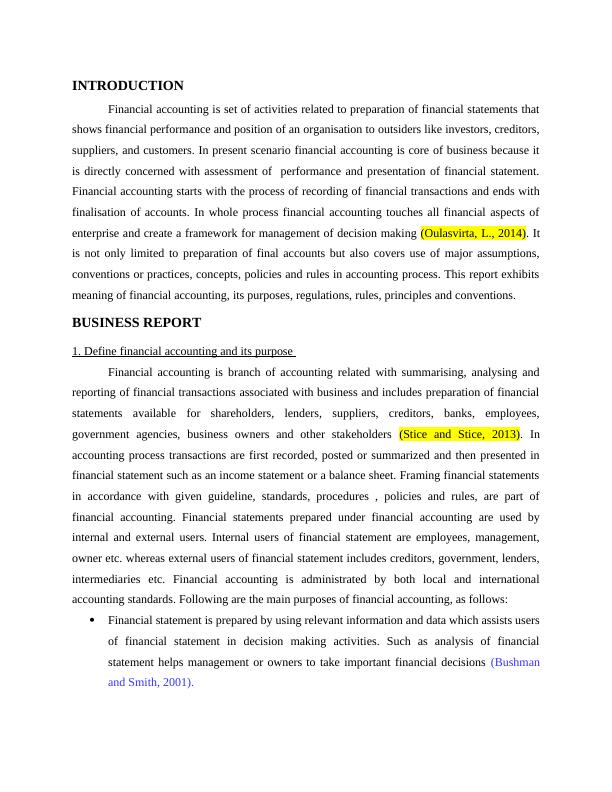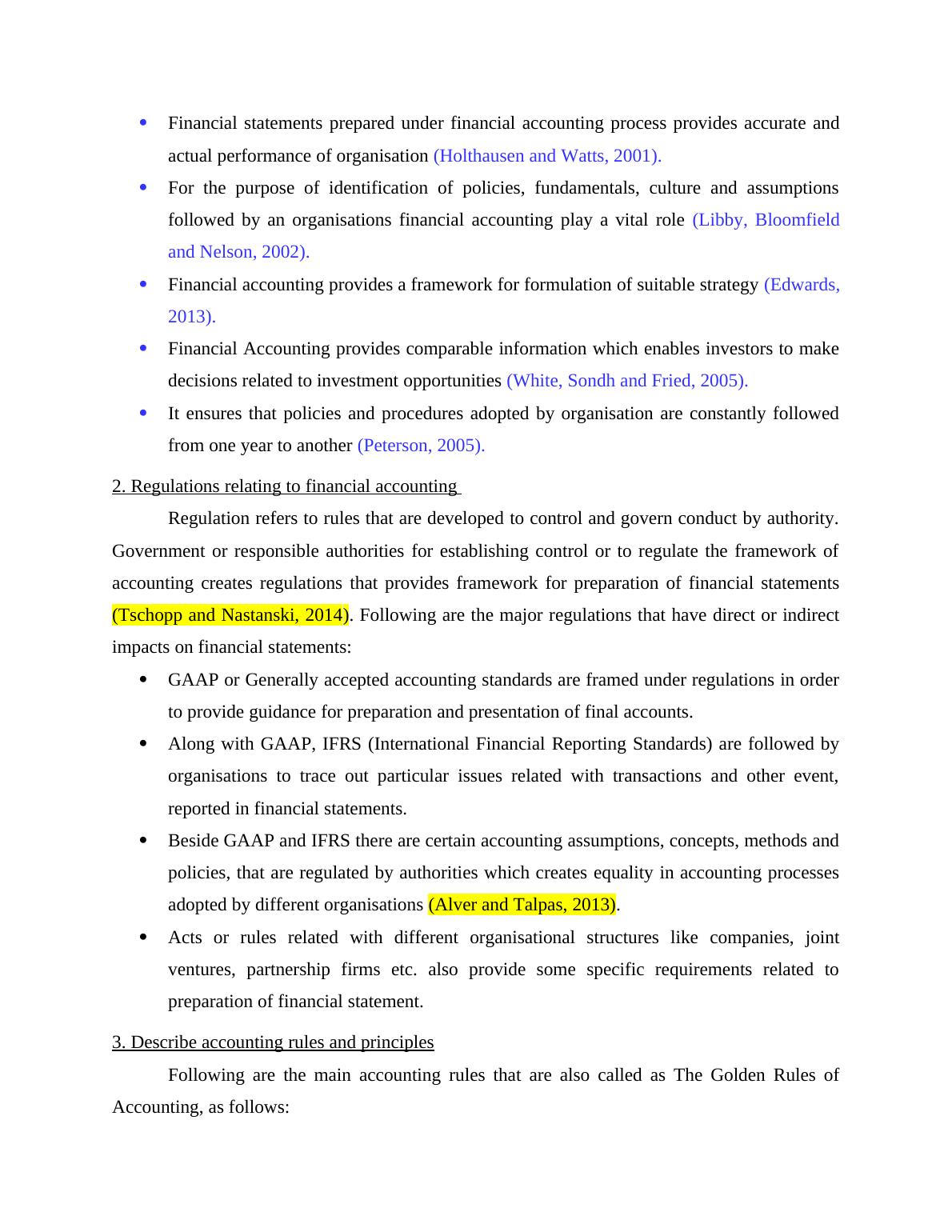Introduction to Financial Accounting
30 Pages5105 Words401 Views
Added on 2020-10-22
About This Document
Financial accounting isbranchofaccounting, accounting procedures available for shareholders, lenders,employees, analysing and reporting of financial transactions associated with business and includes preparation of financial statements.Define financial accounting and its purpose Financial accounting isbranchofaccounting, accounting procedures available for shareholders, lenders,employees, analysing and reporting of financial transactions associated with business and includes preparation of financial statements.Define financial accounting and its purpose Financial accounting isbranchofaccounting, accounting procedures available for shareholders, lenders,
Introduction to Financial Accounting
Added on 2020-10-22
ShareRelated Documents
Financial Accounting

Table of Contents
INTRODUCTION...........................................................................................................................4
BUSINESS REPORT......................................................................................................................4
1. Define financial accounting and its purpose ...........................................................................4
2. Regulations relating to financial accounting ...........................................................................5
3. Describe accounting rules and principles................................................................................5
4. Conventions and concepts relating to consistency and material disclosure............................6
CLIENT 1........................................................................................................................................8
(a) Journal Entry in the books of David Study:..........................................................................8
(b) Ledger Accounts:.................................................................................................................11
(c) Trial Balance as at 31st January, 2018:................................................................................17
CLIENT 2......................................................................................................................................18
(a) Statement of profit and loss for Peter Hampau for the year ended 31st July 2018 .............18
(b) Statement of financial position for Peter Hampau as at ended 31st July 2018 ...................18
CLIENT 3......................................................................................................................................19
(a) Profit and loss account of Bowling Limited.........................................................................19
(b) Balance Sheet of Bowling Limited......................................................................................20
(c) Accounts concepts : Consistency and Prudence:..................................................................20
(d) Purpose of depreciation in formulating accounting statements and methods of
Depreciation:..............................................................................................................................21
CLIENT 4......................................................................................................................................22
(i) Bank reconciliation statement at 1st December 2017:..........................................................22
(ii) Durrell Ltd's updated cash book for December 2017 :........................................................22
(iii) Bank Reconciliation Statement as at 31"t December 2017................................................23
CLIENT 5......................................................................................................................................24
(a) Sales Ledger Control and Purchase Ledger Control Account:.............................................24
(b) Control Account...................................................................................................................24
CLIENT 6......................................................................................................................................25
(a) Suspense Account:................................................................................................................25
(b) Preparation of Trail Balance:...............................................................................................26
INTRODUCTION...........................................................................................................................4
BUSINESS REPORT......................................................................................................................4
1. Define financial accounting and its purpose ...........................................................................4
2. Regulations relating to financial accounting ...........................................................................5
3. Describe accounting rules and principles................................................................................5
4. Conventions and concepts relating to consistency and material disclosure............................6
CLIENT 1........................................................................................................................................8
(a) Journal Entry in the books of David Study:..........................................................................8
(b) Ledger Accounts:.................................................................................................................11
(c) Trial Balance as at 31st January, 2018:................................................................................17
CLIENT 2......................................................................................................................................18
(a) Statement of profit and loss for Peter Hampau for the year ended 31st July 2018 .............18
(b) Statement of financial position for Peter Hampau as at ended 31st July 2018 ...................18
CLIENT 3......................................................................................................................................19
(a) Profit and loss account of Bowling Limited.........................................................................19
(b) Balance Sheet of Bowling Limited......................................................................................20
(c) Accounts concepts : Consistency and Prudence:..................................................................20
(d) Purpose of depreciation in formulating accounting statements and methods of
Depreciation:..............................................................................................................................21
CLIENT 4......................................................................................................................................22
(i) Bank reconciliation statement at 1st December 2017:..........................................................22
(ii) Durrell Ltd's updated cash book for December 2017 :........................................................22
(iii) Bank Reconciliation Statement as at 31"t December 2017................................................23
CLIENT 5......................................................................................................................................24
(a) Sales Ledger Control and Purchase Ledger Control Account:.............................................24
(b) Control Account...................................................................................................................24
CLIENT 6......................................................................................................................................25
(a) Suspense Account:................................................................................................................25
(b) Preparation of Trail Balance:...............................................................................................26

(c) Journal entries in order to show necessary corrections for eliminating suspense account
balance:......................................................................................................................................26
(d) Difference between a Suspense A/c and Clearing A/c:........................................................27
CONCLUSION..............................................................................................................................27
REFERENCES .............................................................................................................................28
balance:......................................................................................................................................26
(d) Difference between a Suspense A/c and Clearing A/c:........................................................27
CONCLUSION..............................................................................................................................27
REFERENCES .............................................................................................................................28

INTRODUCTION
Financial accounting is set of activities related to preparation of financial statements that
shows financial performance and position of an organisation to outsiders like investors, creditors,
suppliers, and customers. In present scenario financial accounting is core of business because it
is directly concerned with assessment of performance and presentation of financial statement.
Financial accounting starts with the process of recording of financial transactions and ends with
finalisation of accounts. In whole process financial accounting touches all financial aspects of
enterprise and create a framework for management of decision making (Oulasvirta, L., 2014). It
is not only limited to preparation of final accounts but also covers use of major assumptions,
conventions or practices, concepts, policies and rules in accounting process. This report exhibits
meaning of financial accounting, its purposes, regulations, rules, principles and conventions.
BUSINESS REPORT
1. Define financial accounting and its purpose
Financial accounting is branch of accounting related with summarising, analysing and
reporting of financial transactions associated with business and includes preparation of financial
statements available for shareholders, lenders, suppliers, creditors, banks, employees,
government agencies, business owners and other stakeholders (Stice and Stice, 2013). In
accounting process transactions are first recorded, posted or summarized and then presented in
financial statement such as an income statement or a balance sheet. Framing financial statements
in accordance with given guideline, standards, procedures , policies and rules, are part of
financial accounting. Financial statements prepared under financial accounting are used by
internal and external users. Internal users of financial statement are employees, management,
owner etc. whereas external users of financial statement includes creditors, government, lenders,
intermediaries etc. Financial accounting is administrated by both local and international
accounting standards. Following are the main purposes of financial accounting, as follows:
Financial statement is prepared by using relevant information and data which assists users
of financial statement in decision making activities. Such as analysis of financial
statement helps management or owners to take important financial decisions (Bushman
and Smith, 2001).
Financial accounting is set of activities related to preparation of financial statements that
shows financial performance and position of an organisation to outsiders like investors, creditors,
suppliers, and customers. In present scenario financial accounting is core of business because it
is directly concerned with assessment of performance and presentation of financial statement.
Financial accounting starts with the process of recording of financial transactions and ends with
finalisation of accounts. In whole process financial accounting touches all financial aspects of
enterprise and create a framework for management of decision making (Oulasvirta, L., 2014). It
is not only limited to preparation of final accounts but also covers use of major assumptions,
conventions or practices, concepts, policies and rules in accounting process. This report exhibits
meaning of financial accounting, its purposes, regulations, rules, principles and conventions.
BUSINESS REPORT
1. Define financial accounting and its purpose
Financial accounting is branch of accounting related with summarising, analysing and
reporting of financial transactions associated with business and includes preparation of financial
statements available for shareholders, lenders, suppliers, creditors, banks, employees,
government agencies, business owners and other stakeholders (Stice and Stice, 2013). In
accounting process transactions are first recorded, posted or summarized and then presented in
financial statement such as an income statement or a balance sheet. Framing financial statements
in accordance with given guideline, standards, procedures , policies and rules, are part of
financial accounting. Financial statements prepared under financial accounting are used by
internal and external users. Internal users of financial statement are employees, management,
owner etc. whereas external users of financial statement includes creditors, government, lenders,
intermediaries etc. Financial accounting is administrated by both local and international
accounting standards. Following are the main purposes of financial accounting, as follows:
Financial statement is prepared by using relevant information and data which assists users
of financial statement in decision making activities. Such as analysis of financial
statement helps management or owners to take important financial decisions (Bushman
and Smith, 2001).

Financial statements prepared under financial accounting process provides accurate and
actual performance of organisation (Holthausen and Watts, 2001).
For the purpose of identification of policies, fundamentals, culture and assumptions
followed by an organisations financial accounting play a vital role (Libby, Bloomfield
and Nelson, 2002).
Financial accounting provides a framework for formulation of suitable strategy (Edwards,
2013).
Financial Accounting provides comparable information which enables investors to make
decisions related to investment opportunities (White, Sondh and Fried, 2005).
It ensures that policies and procedures adopted by organisation are constantly followed
from one year to another (Peterson, 2005).
2. Regulations relating to financial accounting
Regulation refers to rules that are developed to control and govern conduct by authority.
Government or responsible authorities for establishing control or to regulate the framework of
accounting creates regulations that provides framework for preparation of financial statements
(Tschopp and Nastanski, 2014). Following are the major regulations that have direct or indirect
impacts on financial statements:
GAAP or Generally accepted accounting standards are framed under regulations in order
to provide guidance for preparation and presentation of final accounts.
Along with GAAP, IFRS (International Financial Reporting Standards) are followed by
organisations to trace out particular issues related with transactions and other event,
reported in financial statements.
Beside GAAP and IFRS there are certain accounting assumptions, concepts, methods and
policies, that are regulated by authorities which creates equality in accounting processes
adopted by different organisations (Alver and Talpas, 2013).
Acts or rules related with different organisational structures like companies, joint
ventures, partnership firms etc. also provide some specific requirements related to
preparation of financial statement.
3. Describe accounting rules and principles
Following are the main accounting rules that are also called as The Golden Rules of
Accounting, as follows:
actual performance of organisation (Holthausen and Watts, 2001).
For the purpose of identification of policies, fundamentals, culture and assumptions
followed by an organisations financial accounting play a vital role (Libby, Bloomfield
and Nelson, 2002).
Financial accounting provides a framework for formulation of suitable strategy (Edwards,
2013).
Financial Accounting provides comparable information which enables investors to make
decisions related to investment opportunities (White, Sondh and Fried, 2005).
It ensures that policies and procedures adopted by organisation are constantly followed
from one year to another (Peterson, 2005).
2. Regulations relating to financial accounting
Regulation refers to rules that are developed to control and govern conduct by authority.
Government or responsible authorities for establishing control or to regulate the framework of
accounting creates regulations that provides framework for preparation of financial statements
(Tschopp and Nastanski, 2014). Following are the major regulations that have direct or indirect
impacts on financial statements:
GAAP or Generally accepted accounting standards are framed under regulations in order
to provide guidance for preparation and presentation of final accounts.
Along with GAAP, IFRS (International Financial Reporting Standards) are followed by
organisations to trace out particular issues related with transactions and other event,
reported in financial statements.
Beside GAAP and IFRS there are certain accounting assumptions, concepts, methods and
policies, that are regulated by authorities which creates equality in accounting processes
adopted by different organisations (Alver and Talpas, 2013).
Acts or rules related with different organisational structures like companies, joint
ventures, partnership firms etc. also provide some specific requirements related to
preparation of financial statement.
3. Describe accounting rules and principles
Following are the main accounting rules that are also called as The Golden Rules of
Accounting, as follows:

Debit the receiver, credit the giver: This rule is applied for personal accounts. A
Personal account is a General ledger account related to all persons like individuals, firms and
associations for example debtors account, banks account, creditors account, capital account etc.
If an individual give something to organisation it treated as inflow so personal account will be
credited and if individual receive something from the organisation than amount must be debit on
name of individual (Hale and Held, 2012).
Debit all expenses and losses, credit all incomes and gains: This rule is used in case of
nominal account. A Nominal account is a General ledger account related to all income, expenses,
losses and gains. Under this rule capital is considered as liability for business and liability shows
credit balances. Incomes and gains increases the capital so all incomes and gains are credited
whereas debit all expenses and losses because expenses or losses decreases the capital (Khan and
Mayes, 2009).
Debit what comes in, credit what goes out: This rule is used in case of real account. All
assets of a firm whether tangible or intangible are Real Accounts such as machinery account,
land and buildings account etc. There are two types of real account: Tangible real accounts and
Intangible real accounts. Tangible real accounts includes building account, machinery accounts,
stock stock account, land account, etc. Whereas Intangible real accounts refer to account related
to things that can’t be touched such as goodwill, patents, trademarks etc (Saunders, Cornett and
McGraw, 2006).
Principles:
Dual aspect concept: Dual aspect concept is purely based upon double entry system of
accounting. According to this principle every business transaction affects two accounts
simultaneously. In which credit side of one account and debit side of another always be affected
due to double entry system (Zeff, S. A., 2016). In Single entry system only one aspect of the
transaction is recorded which sometimes seems irrelevant. So in order to avoid practice of single
entry system dual aspect concept is developed.
Cost principle: According to this principle asset should always be reported on their cost..
In simple words it can be say that organisation should record their assets on value paid for the
assets (Barth, 2015).
Matching principle: As per this principle, all expenses of business should be matched
with the revenues which are generated in same accounting period.
Personal account is a General ledger account related to all persons like individuals, firms and
associations for example debtors account, banks account, creditors account, capital account etc.
If an individual give something to organisation it treated as inflow so personal account will be
credited and if individual receive something from the organisation than amount must be debit on
name of individual (Hale and Held, 2012).
Debit all expenses and losses, credit all incomes and gains: This rule is used in case of
nominal account. A Nominal account is a General ledger account related to all income, expenses,
losses and gains. Under this rule capital is considered as liability for business and liability shows
credit balances. Incomes and gains increases the capital so all incomes and gains are credited
whereas debit all expenses and losses because expenses or losses decreases the capital (Khan and
Mayes, 2009).
Debit what comes in, credit what goes out: This rule is used in case of real account. All
assets of a firm whether tangible or intangible are Real Accounts such as machinery account,
land and buildings account etc. There are two types of real account: Tangible real accounts and
Intangible real accounts. Tangible real accounts includes building account, machinery accounts,
stock stock account, land account, etc. Whereas Intangible real accounts refer to account related
to things that can’t be touched such as goodwill, patents, trademarks etc (Saunders, Cornett and
McGraw, 2006).
Principles:
Dual aspect concept: Dual aspect concept is purely based upon double entry system of
accounting. According to this principle every business transaction affects two accounts
simultaneously. In which credit side of one account and debit side of another always be affected
due to double entry system (Zeff, S. A., 2016). In Single entry system only one aspect of the
transaction is recorded which sometimes seems irrelevant. So in order to avoid practice of single
entry system dual aspect concept is developed.
Cost principle: According to this principle asset should always be reported on their cost..
In simple words it can be say that organisation should record their assets on value paid for the
assets (Barth, 2015).
Matching principle: As per this principle, all expenses of business should be matched
with the revenues which are generated in same accounting period.

End of preview
Want to access all the pages? Upload your documents or become a member.
Related Documents
Finance Accounting INTRODUCTION 4 BUSINESS RPORTlg...
|25
|7261
|384
Financial Accounting Assignment - Zync Solutionslg...
|29
|5360
|97
Financial Accounting Principles Assignment - RBS Accountants Ltdlg...
|26
|7021
|485
1.Financial Accounting and its Purposeslg...
|27
|6999
|247
Financial Accounting Principles INTRODUCTIONlg...
|27
|6810
|416
Financial Accounting Principles Assignment - Doclg...
|30
|7212
|286
